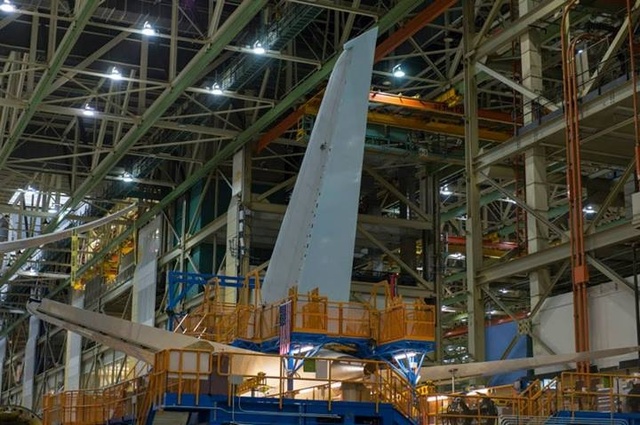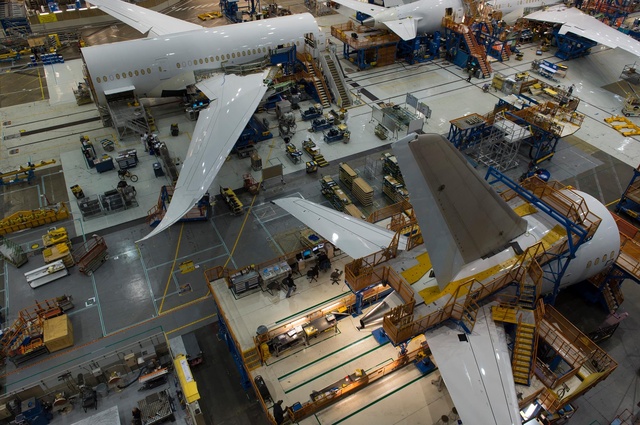August 30, 2014
Surge Position 1
Photography inside the factory isn't allowed, but a few publicly released images can be found. Here are two showing where I work.
In the lower part of the picture is the 48 Join Stand, that's where the tailcone, which houses the APU and has the horizontal stabilizer attached to two giant pivots on its front is mated to the "48 Section", which is the portion of the fuselage aft of the pressure dome. Forward of the pressure dome is the 47 section, where the galley and bathrooms are.
On the upper side of the picture is the Wing/Body Join area, and to the right of that is where the forward and aft joins are performed. That's also where that recent lift and deburr that I mentioned a couple of posts ago occurred. You can see why the catwalk was sorely missed, even though we're not terribly fond of it either.

Click to Embiggen
The view from the floor. That big thing on top, putting it on is my job. Including the one on THIS beauty:
Man, I never get tired of watching that one.
Comments are disabled.
In the lower part of the picture is the 48 Join Stand, that's where the tailcone, which houses the APU and has the horizontal stabilizer attached to two giant pivots on its front is mated to the "48 Section", which is the portion of the fuselage aft of the pressure dome. Forward of the pressure dome is the 47 section, where the galley and bathrooms are.
On the upper side of the picture is the Wing/Body Join area, and to the right of that is where the forward and aft joins are performed. That's also where that recent lift and deburr that I mentioned a couple of posts ago occurred. You can see why the catwalk was sorely missed, even though we're not terribly fond of it either.

Click to Embiggen
The view from the floor. That big thing on top, putting it on is my job. Including the one on THIS beauty:
Man, I never get tired of watching that one.
Posted by: Mauser at
04:43 PM
| Comments (2)
| Add Comment
Post contains 190 words, total size 2 kb.
1
I'm sure there's perfectly good aerodynamic and fuel consumption reasoning to have the wings angled up the way they are, but to me, someone who knows just enough about that kind of thing to be able to draw the wrong conclusions, it looks like they're trying so very hard to break away from the fuselage.
Posted by: Wonderduck at August 30, 2014 10:09 PM (eNsTS)
2
The wings are carbon fiber, they flex a bit more than the aluminum wing (Which also bend a lot.). It contributes to the smoother ride. It might be somewhere on Youtube, but I've seen the stress test video. They take one of the first airframes clamp it into a big steel frame, attach cables all over it, and haul on the wings up to 150% of the maximum physically possible air load. Typically on the aluminum planes, that's where they break. On the Dreamliner, they didn't. but the tips came up something like 30 or 40 feet.
In flight they go from about even with the windows to about even with the top of the plane.
Let's see, breaking the 787 wing spar:
I can't find the actual full wing test, they went 151% and stopped without breaking it. (Some fool put up the 777 video and labeled it 787)
Breaking a 777 wing
In flight they go from about even with the windows to about even with the top of the plane.
Let's see, breaking the 787 wing spar:
I can't find the actual full wing test, they went 151% and stopped without breaking it. (Some fool put up the 777 video and labeled it 787)
Breaking a 777 wing
Posted by: Mauser at August 30, 2014 11:45 PM (TJ7ih)
23kb generated in CPU 0.0095, elapsed 0.0443 seconds.
33 queries taking 0.0369 seconds, 214 records returned.
Powered by Minx 1.1.6c-pink.
33 queries taking 0.0369 seconds, 214 records returned.
Powered by Minx 1.1.6c-pink.















